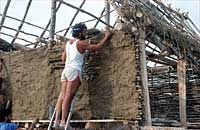- Home
- The house
- Building a Neolithic house
- Putting up the walls
The walls were made from wattles cut from the hazelnut tree. The regularity of such archaeological wattling indicates that we are dealing with walls that were literally woven using carefully-selected twigs.
At Chalain, the walls were coated with a mixture of local calcareous marls (from glacial lacustrine deposits) and damp primary-forest moss (Neckera crispa), which one can still find deep in the pocket valleys that cut into the region's limestone plateaux. We see once again that the forest is the best source for construction materials.
As for the facades, several triangular gable tops were found at Chalain. All are remarkably finished, with a systematic use of clematis — a vine that becomes supple with soaking or heating — to close up the facade just under the roof. For archaeologists, the discovery of these tops revealed something else quite interesting: the angle of the roof.
Putting up the watling.
Putting up the watling.
Wattle gable top.
Chalain 3, 31st century BCE.



